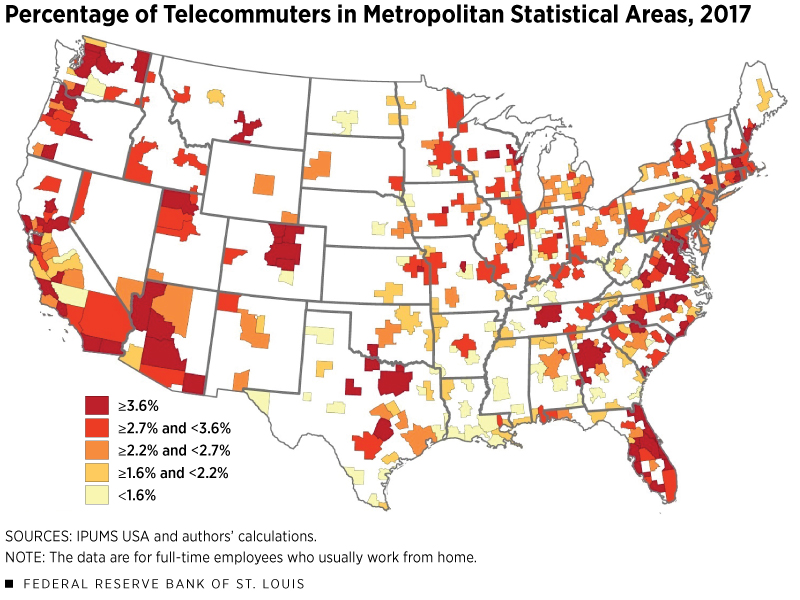Factors That Influence Being Able to Telecommute
This is the second in a two-part series on the growth of telecommuting and what may be behind this growth.
In the previous post, Regional Economist Charles Gascon, former Research Intern Iris Arbogast and former Research Associate Andrew Spewak determined that technological advances, rather than occupational shifts in the labor force, likely explained the rising share of telecommuting workers in recent years.
Still, the authors found that occupational differences played a role in explaining the local disparities in telecommuting.
In 2017, the share of telecommuters in metropolitan statistical areas across the U.S. ranged from below 1% in Houma, La., to nearly 9% in Boulder, Colo. (See map below.)

“While occupation was not a key driver of national growth in working from home over time, we did find it important for explaining geographic variations in telecommuting,” they wrote. “Once we controlled for income, a region’s occupational mix was a significant predictor of the telecommuting share in metro areas.”
For example, the St. Louis metro area had a telecommuting share of 3.1%, while Memphis, Tenn., had a share just below 2.2%.
Part of these differences can be explained by the share of workers in management, business and financial occupations. “In St. Louis, 18.6% of workers are in these occupations, which tend to have a higher portion of employees working from home, while only 14.8% of workers are in these occupations in the Memphis metro area,” Gascon, Arbogast and Spewak wrote.
Which Workers Are More Likely to Telecommute
Besides occupation, they noted other characteristics that make telecommuting more likely for a worker: age and level of education, and whether one has children or lives in a metro area.
How do such factors affect the likelihood of being a telecommuter?
- Those who are college-educated are 58% more likely to work from home, holding everything else constant.
- Workers in metro areas are 74% more likely to telecommute than those in nonmetro areas.
The combination of these factors helps explain why some people are much more likely to telecommute than others.
“To give an example, a college-educated 40-year-old with a young child and who works in sales in a large city is predicted as having a 5.2% chance of being a telecommuter,” they wrote. “Meanwhile, a high school-educated 20-year-old with no children and who works in production in a rural area is predicted as having a 0.03% chance of being someone who works from home,” Gascon, Arbogast and Spewak wrote.
These factors explain almost all the variation in telecommuting rates across regions of the country, they said.
Additional Resources
- Regional Economist: Working from Home: More Americans Are Telecommuting
- On the Economy: The Rise of Robots in the Workplace
- On the Economy: The White Working Class: State-Level Declines and Geographic Concentration
Citation
ldquoFactors That Influence Being Able to Telecommute,rdquo St. Louis Fed On the Economy, Jan. 9, 2020.
This blog offers commentary, analysis and data from our economists and experts. Views expressed are not necessarily those of the St. Louis Fed or Federal Reserve System.
Email Us
All other blog-related questions

